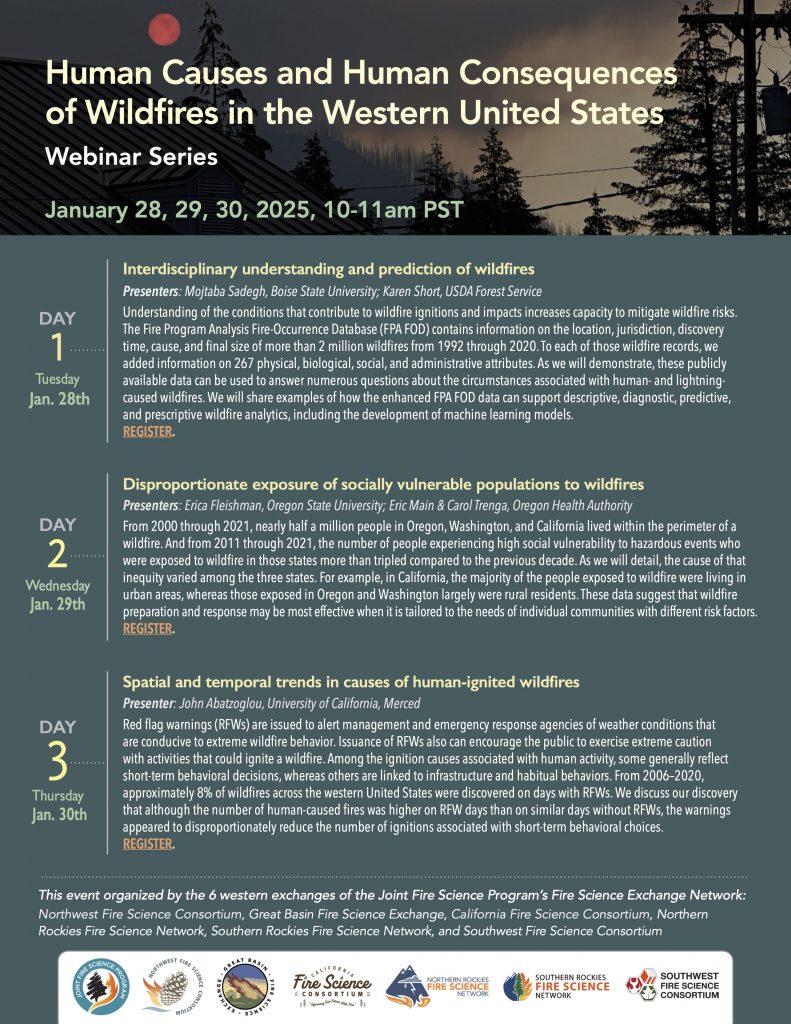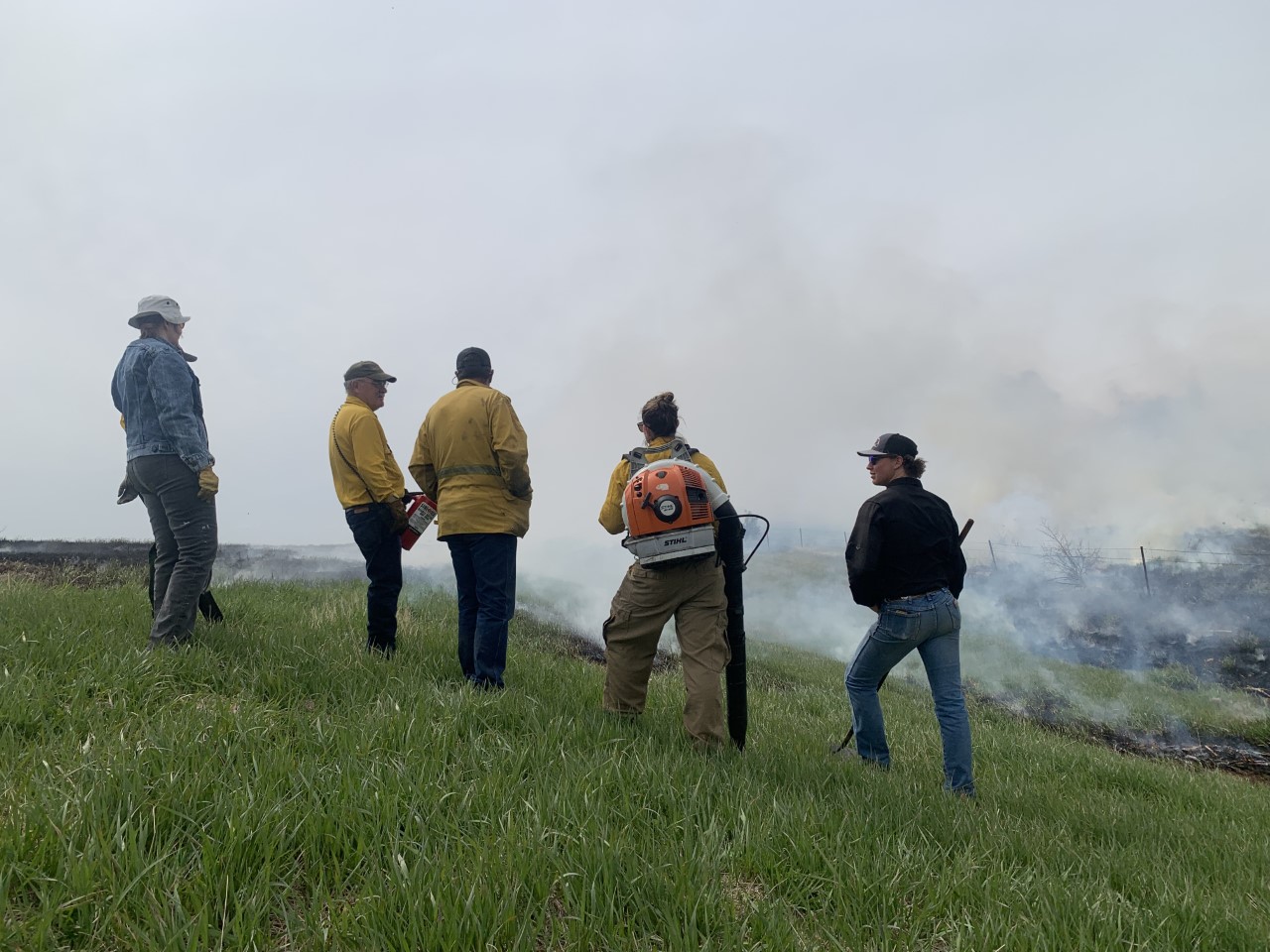In a nutshell: Three webinars over three days explore conditions that contribute to wildfire ignitions, how preparation and response need to be tailored to fit the affected community, and how red flag warnings help reduce fire ignitions.
Interdisciplinary understanding and prediction of wildfires
Presenters: Mojtaba Sadegh, Boise State University; Karen Short, USDA Forest Service
Understanding of the conditions that contribute to wildfire ignitions and impacts increases capacity to mitigate wildfire risks. The Fire Program Analysis Fire-Occurrence Database (FPA FOD) contains information on the location, jurisdiction, discovery time, cause, and final size of more than 2 million wildfires from 1992 through 2020. To each of those wildfire records, we added information on 267 physical, biological, social, and administrative attributes. As we will demonstrate, these publicly available data can be used to answer numerous questions about the circumstances associated with human- and lightning-caused wildfires. We will share examples of how the enhanced FPA FOD data can support descriptive, diagnostic, predictive, and prescriptive wildfire analytics, including the development of machine learning models.
RELATED LINKS
Trauma informed toolkit: https://extension.oregonstate.edu/catalog/pub/em-9348-trauma-informed-toolkit
Physical, social, and biological attributes for improved understanding and prediction of wildfires: FPA FOD-Attributes dataset
A spatial database of wildfires in the United States, 1992-2011
Latest (6th edition) data product: https://www.fs.usda.gov/rds/archive/catalog/RDS-2013-0009.6
ICS-209-PLUS: All-hazards dataset mined from the US National Incident Management System 1999–2020
Monitoring Trends in Burn Severity
To visualize the data: https://fpafod.boisestate.edu/Data
Inference of Wildfire Causes From Their Physical, Biological, Social and Management Attributes
Disproportionate exposure of human populations to wildfires
Presenters: Erica Fleishman, Oregon State University; Eric Main & Carol Trenga, Oregon Health Authority
From 2000 through 2021, nearly half a million people in Oregon, Washington, and California lived within the perimeter of a wildfire. And from 2011 through 2021, the number of people experiencing vulnerability to hazardous events who were exposed to wildfire in those states more than tripled compared to the previous decade. For example, in California, the majority of the people exposed to wildfire were living in urban areas, whereas those exposed in Oregon and Washington largely were rural residents. These data suggest that wildfire preparation and response may be most effective when it is tailored to the needs of individual communities with different risk factors.
RELATED LINKS
OSU Extension Fire Program: https://extension.oregonstate.edu/fire-program
Trauma informed toolkit: https://extension.oregonstate.edu/catalog/pub/em-9348-trauma-informed-toolkit
Research article: Social vulnerability of the people exposed to wildfires in U.S. West Coast states
Study of exposure to wildland fire across the US: https://escholarship.org/content/qt3v07d63s/qt3v07d63s.pdf
Resources links for programs & projects mentioned in the presentation:
Air Quality and Outdoor Activity Guidance for Infants, Children and Youth https://sharedsystems.dhsoha.state.or.us/DHSForms/Served/le8815H.pdf
Climate Change and Public Health, including Annual Climate & Health Report https://www.oregon.gov/oha/ph/healthyenvironments/climatechange/pages/index.aspx
Public Health Accountability Metrics https://www.oregon.gov/oha/ph/about/pages/accountabilitymetrics.aspx
Oregon Health Plan (OHP) Climate Supports https://www.oregon.gov/OHA/HSD/OHP/Pages/Climate-Supports.aspx
Public health modernization
- Public Health Modernization for environmental health: https://www.oregon.gov/oha/PH/ABOUT/TASKFORCE/Documents/Public-Health-Modernization-for-Environmental-Health-June-2022.pdf
- Funding for Community-Based Organizations, Local Public Health and Tribal Governments; information about local adaptation planning and partners: https://www.oregon.gov/oha/ph/healthyenvironments/climatechange/pages/local-adaptation-planning.aspx
- Healthy Homes Grant Program https://www.oregon.gov/oha/ph/healthyenvironments/healthyneighborhoods/healthyhomesgrantprogram/pages/index.aspx
- 1/16/25 OHA news release: Tribes, 34 organizations, receive $23 million to support home repairs (OHA’s Healthy Homes Grant Program)https://content.govdelivery.com/accounts/ORHA/bulletins/3cd2531
Resources shared by other attendees:
The California Department of Forestry and Fire Protection (CAL FIRE) now provides basic demographic information for fire areas as a part of its website (https://www.fire.ca.gov/) incident reporting. For example, the demographic information for the current Palisades Incident in the Los Angeles area can be found here: https://incidents.fire.ca.gov/media/0mzhu50v/palisades-fire.pdf
Eaton: https://incidents.fire.ca.gov/media/1lqbnqmi/eaton-fire-demographics.pdf You can find these links under the individual incidents listed on our home page. Just click on the incident and scroll down.
The ESRI Wildfire Aware website includes demographic info in the right panel. https://livingatlas.arcgis.com/wildfireaware/#ext=-118.482,34.076,12,loc=72660ADC-B5EF-4D96-A33F-B4EA3740A4E3
Article that critiques the concept of vulnerability. https://www.tandfonline.com/doi/full/10.1080/14616742.2024.2432409#abstract
Spatial and temporal trends in causes of human-ignited wildfires
Presenter: John Abatzoglou, University of California, Merced
Red flag warnings (RFWs) are issued to alert management and emergency response agencies of weather conditions that are conducive to extreme wildfire behavior. Issuance of RFWs also can encourage the public to exercise extreme caution with activities that could ignite a wildfire. Among the ignition causes associated with human activity, some generally reflect short-term behavioral decisions, whereas others are linked to infrastructure and habitual behaviors. From 2006–2020, approximately 8% of wildfires across the western United States were discovered on days with RFWs. We discuss our discovery that although the number of human-caused fires was higher on RFW days than on similar days without RFWs, the warnings appeared to disproportionately reduce the number of ignitions associated with short-term behavioral choices.
RELATED LINKS
The Efficacy of Red Flag Warnings in Mitigating Human-Caused Wildfires across the Western United States:
A pdf is also available for download at: https://blogs.oregonstate.edu/occri/recent-peer-reviewed-publications/
NW Fire Science Consortium short video on Red Flag Warnings
The Southern Rockies Fire Science Network produced a summary of a Burn Ban Effectiveness assessment after the fires of 2020:
These webinars were hosted by the Northwest Fire Science Consortium and coordinated by six JFSP Fire Exchange Networks located in the western United States.
FLYER OF THE 3-WEBINAR SERIES


